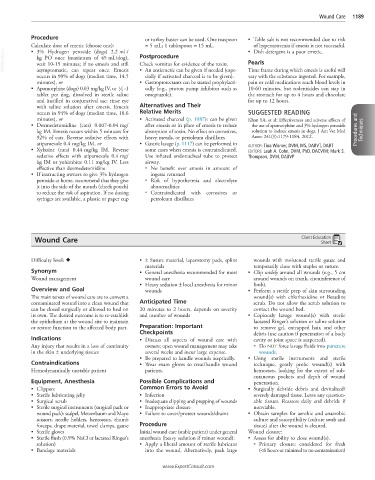Page 2404 - Cote clinical veterinary advisor dogs and cats 4th
P. 2404
Wound Care 1189
Procedure or turkey baster can be used. One teaspoon • Table salt is not recommended due to risk
of hypernatremia if emesis is not successful.
Calculate dose of emetic (choose one): = 5 mL; 1 tablespoon = 15 mL. • Dish detergent is a poor emetic.
VetBooks.ir kg PO once (maximum of 45 mL/dog), Postprocedure Pearls
• 3% Hydrogen peroxide (dogs) 2.2 mL/
wait 10-15 minutes; if no emesis and still
Check vomitus for evidence of the toxin.
asymptomatic, can repeat once. Emesis
occurs in 90% of dogs (median time, 14.5 • An antiemetic can be given if needed (espe- Time frame during which emesis is useful will
cially if activated charcoal is to be given).
vary with the substance ingested. For example,
minutes), or • Gastroprotectants can be started prophylacti- pain or cold medications reach blood levels in
• Apomorphine (dogs) 0.03 mg/kg IV, or 1 4 -1 cally (e.g., proton pump inhibitor such as 10-60 minutes, but rodenticides can stay in
tablet per dog, dissolved in sterile saline omeprazole). the stomach for up to 4 hours and chocolate
and instilled in conjunctival sac; rinse eye for up to 12 hours.
with saline solution after emesis. Emesis Alternatives and Their
occurs in 94% of dogs (median time, 18.6 Relative Merits SUGGESTED READING
minutes), or • Activated charcoal (p. 1087): can be given Khan SA, et al: Effectiveness and adverse effects of
• Dexmedetomidine (cats) 0.007-0.04 mg/ after emesis or in place of emesis to reduce the use of apomorphine and 3% hydrogen peroxide
kg IM. Emesis occurs within 5 minutes for absorption of toxin. No effect on corrosives, solution to induce emesis in dogs. J Am Vet Med Procedures and Procedures and Techniques Techniques
92% of cats. Reverse sedative effects with heavy metals, or petroleum distillates Assoc 241(9):1179-1184, 2012.
atipamezole 0.4 mg/kg IM, or • Gastric lavage (p. 1117) can be performed in AUTHOR: Tina Wismer, DVM, MS, DABVT, DABT
• Xylazine (cats) 0.44 mg/kg IM. Reverse some cases when emesis is contraindicated. EDITORS: Leah A. Cohn, DVM, PhD, DACVIM; Mark S.
sedative effects with atipamezole 0.4 mg/ Use inflated endotracheal tube to protect Thompson, DVM, DABVP
kg IM or yohimbine 0.11 mg/kg IV. Less airway.
effective than dexmedetomidine ○ No benefit over emesis in amount of
• If instructing owners to give 3% hydrogen ingesta returned
peroxide at home, recommend that they give ○ Risk of hypothermia and electrolyte
it into the side of the mouth (cheek pouch) abnormalities
to reduce the risk of aspiration. If no dosing ○ Contraindicated with corrosives or
syringes are available, a plastic or paper cup petroleum distillates
Wound Care Client Education
Sheet
Difficulty level: ♦ • ± Suture material, laparotomy pads, splint wounds with moistened sterile gauze and
materials temporarily close with staples or suture.
Synonym • General anesthesia recommended for most • Clip widely around all wounds (e.g., 5 cm
Wound management wound care around wounds on trunk, circumference of
• Heavy sedation ± local anesthesia for minor limb).
Overview and Goal wounds • Perform a sterile prep of skin surrounding
The main tenets of wound care are to convert a wound(s) with chlorhexidine or Betadine
contaminated wound into a clean wound that Anticipated Time scrub. Do not allow the scrub solution to
can be closed surgically or allowed to heal on 20 minutes to 2 hours, depends on severity contact the wound bed.
its own. The desired outcome is to re-establish and number of wounds • Copiously lavage wound(s) with sterile
the epithelium at the wound site to maintain lactated Ringer’s solution or saline solution
or restore function to the affected body part. Preparation: Important to remove gel, entrapped hair, and other
Checkpoints debris (use caution if penetration of a body
Indications • Discuss all aspects of wound care with cavity or joint space is suspected).
Any injury that results in a loss of continuity owners; open wound management may take ○ Do NOT force lavage fluids into puncture
in the skin ± underlying tissues several weeks and incur large expense. wounds.
• Be prepared to handle wounds aseptically. • Using sterile instruments and sterile
Contraindications • Wear exam gloves to treat/handle wound technique, gently probe wound(s) with
Hemodynamically unstable patient patients. hemostats, looking for the extent of sub-
cutaneous pockets and depth of wound
Equipment, Anesthesia Possible Complications and penetration.
• Clippers Common Errors to Avoid • Surgically debride debris and devitalized/
• Sterile lubricating jelly • Infection severely damaged tissue. Leave any question-
• Surgical scrub • Inadequate clipping and prepping of wounds able tissues. Reassess daily and debride if
• Sterile surgical instruments (surgical pack or • Inappropriate closure nonviable.
wound pack): scalpel, Metzenbaum and Mayo • Failure to cover/protect wounds/drains • Obtain samples for aerobic and anaerobic
scissors, needle holders, hemostats, thumb culture and susceptibility (culture swab and
forceps, drape material, towel clamps, gauze Procedure tissue) after the wound is cleaned.
• Sterile gloves Initial wound care (stable patient) under general Wound closure:
• Sterile flush (0.9% NaCl or lactated Ringer’s anesthesia (heavy sedation if minor wound): • Assess for ability to close wound(s).
solution) • Apply a liberal amount of sterile lubricant ○ Primary closure: considered for fresh
• Bandage materials into the wound. Alternatively, pack large (<6 hours or minimal to no contamination)
www .ExpertConsult.com
www.ExpertConsult.com

